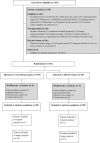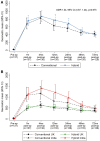Shortening cardioplegic arrest time in patients undergoing combined coronary and valve surgery: results from a multicentre randomized controlled trial: the SCAT trial
- PMID: 28444178
- PMCID: PMC5848808
- DOI: 10.1093/ejcts/ezx087
Shortening cardioplegic arrest time in patients undergoing combined coronary and valve surgery: results from a multicentre randomized controlled trial: the SCAT trial
Abstract
Objectives: Combined coronary artery bypass grafting and valve surgery requires a prolonged period of cardioplegic arrest (CA) predisposing to myocardial injury and postoperative cardiac-specific complications. The aim of this trial was to reduce the CA time in patients undergoing combined coronary artery bypass grafting and valve surgery and assess if this was associated with less myocardial injury and related complications.
Methods: Participants were randomized to (i) coronary artery bypass grafting performed on the beating heart with cardiopulmonary bypass support followed by CA for the valve procedure (hybrid) or (ii) both procedures under CA (conventional). To assess complications related to myocardial injury, we used the composite of death, myocardial infarction, arrhythmia, need for pacing or inotropes for >12 h. To assess myocardial injury, we used serial plasma troponin T and markers of metabolic stress in myocardial biopsies.
Results: Hundred and sixty patients (80 hybrid and 80 conventional) were randomized. Mean age was 66.5 years and 74% were male. Valve procedures included aortic (61.8%) and mitral (33.1%) alone or in combination (5.1%). CA time was 16% lower in the hybrid group [median 98 vs 89 min, geometric mean ratio (GMR) 0.84, 95% confidence interval (CI) 0.77-0.93, P = 0.0004]. Complications related to myocardial injury occurred in 131/160 patients (64/80 conventional, 67/80 hybrid), odds ratio 1.24, 95% CI 0.54-2.86, P = 0.61. Release of troponin T was similar between groups (GMR 1.04, 95% CI 0.87-1.24, P = 0.68). Adenosine monophosphate was 28% lower in the hybrid group (GMR 0.72, 95% CI 0.51-1.02, P = 0.056).
Conclusions: The hybrid procedure reduced the CA time but myocardial injury outcomes were not superior to conventional approach.
Trial registration: ISRCTN65770930.
Keywords: Beating heart coronary surgery; Cardioplegic arrest; Myocardial protection; Valve surgery.
© The Author 2017. Published by Oxford University Press on behalf of the European Association for Cardio-Thoracic Surgery.
Figures




Similar articles
-
The use of del Nido cardioplegia in adult cardiac surgery: A prospective randomized trial.J Thorac Cardiovasc Surg. 2018 Mar;155(3):1011-1018. doi: 10.1016/j.jtcvs.2017.09.146. Epub 2017 Nov 13. J Thorac Cardiovasc Surg. 2018. PMID: 29246552 Free PMC article. Clinical Trial.
-
Aortic and mitral valve surgery on the beating heart is lowering cardiopulmonary bypass and aortic cross clamp time.Heart Surg Forum. 2002;5(2):182-6. Heart Surg Forum. 2002. PMID: 12125670
-
Emergency coronary artery bypass graft surgery for acute coronary syndrome: beating heart versus conventional cardioplegic cardiac arrest strategies.Circulation. 2006 Jul 4;114(1 Suppl):I477-85. doi: 10.1161/CIRCULATIONAHA.105.001545. Circulation. 2006. PMID: 16820622
-
On-pump coronary surgery with and without cardioplegic arrest: comparison of inflammation, myocardial, cerebral and renal injury and early and late health outcome in a single-centre randomised controlled trial.Eur J Cardiothorac Surg. 2011 May;39(5):675-83. doi: 10.1016/j.ejcts.2010.08.032. Epub 2010 Sep 29. Eur J Cardiothorac Surg. 2011. PMID: 20884221 Clinical Trial.
-
Should we consider beating-heart on-pump coronary artery bypass grafting over conventional cardioplegic arrest to improve postoperative outcomes in selected patients?Interact Cardiovasc Thorac Surg. 2015 Apr;20(4):538-45. doi: 10.1093/icvts/ivu425. Epub 2014 Dec 21. Interact Cardiovasc Thorac Surg. 2015. PMID: 25535178 Review.
Cited by
-
The value of off-pump coronary artery bypass grafting in the surgery for combined valvular and coronary heart disease.Front Med (Lausanne). 2024 Nov 21;11:1451778. doi: 10.3389/fmed.2024.1451778. eCollection 2024. Front Med (Lausanne). 2024. PMID: 39640972 Free PMC article.
-
Human coronary microvascular contractile dysfunction associates with viable synthetic smooth muscle cells.Cardiovasc Res. 2022 Jun 29;118(8):1978-1992. doi: 10.1093/cvr/cvab218. Cardiovasc Res. 2022. PMID: 34173824 Free PMC article.
References
-
- Bridgewater B, Keogh B, Kinsman R, Walton P.. Sixth National Adult Cardiac Surgical Database Report, 2008. http://www.scts.org/_userfiles/resources/SixthNACDreport2008withcovers.org.
-
- Buth KJ, Gainer RA, Legare JF, Hirsch GM.. The changing face of cardiac surgery: practice patterns and outcomes 2001-2010. Can J Cardiol 2014;30:224–30. - PubMed
-
- Keogh B, Kinsman R.. National Adult Cardiac Surgical Database 1999–2000. Dendrite Clinical Systems/ The Society of Cardiothoracic Surgeons of Great Britain and Ireland, 2003.
-
- Edwards FH, Peterson ED, Coombs LP, DeLong ER, Jamieson WR, Shroyer ALW. et al. Prediction of operative mortality after valve replacement surgery. JACC 2001;37:885–92. - PubMed
Publication types
MeSH terms
Grants and funding
LinkOut - more resources
Full Text Sources
Other Literature Sources
Medical
Molecular Biology Databases
Research Materials

